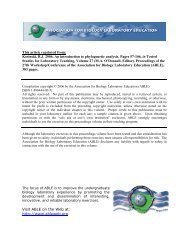Organelle Isolation and Marker Enzyme Assay - Association for ...
Organelle Isolation and Marker Enzyme Assay - Association for ...
Organelle Isolation and Marker Enzyme Assay - Association for ...
You also want an ePaper? Increase the reach of your titles
YUMPU automatically turns print PDFs into web optimized ePapers that Google loves.
142 <strong>Organelle</strong> <strong>Isolation</strong><br />
APPENDIX B<br />
Growing Cells of Dictyostelium discoideum<br />
Loomis (1982) provides a comprehensive treatise on this organism. D. discoideum is a eukaryotic<br />
microorganism which can be easily grown in the laboratory. The axenic strain Ax-3 used in this exercise can<br />
be obtained either from the American Type Culture Collection or from any one of the numerous research<br />
laboratories throughout the world who work on this organism. Cells are grown in axenic medium (known as<br />
HL-5) in sterile flasks (250-ml flasks with 50–100 ml medium or 500-ml flask with 100–200 ml medium).<br />
Cells are grown on a rotary shaker (160 rpm) at room temperature. Cells will not survive<br />
temperatures higher than 25°C. Doubling time is 10–12 hours. Collect cells when density of cells is 5 × 10 6<br />
to 1.5 × 10 7 /ml. Cells can be harvested in clinical centrifuge at 500 g (about 1,500 rpm) <strong>for</strong> 5 minutes.<br />
Resuspend cells in Buffer A <strong>and</strong> centrifuge again.<br />
Cell viability could be tested by mixing 1 part of cell suspension with 1 part of 0.4% Trypan blue in<br />
buffer. Observe under a microscope. Healthy cells remain colorless while dead cells take up blue color.<br />
Homogenization of cells by passing them through polycarbonate nucleopore filters is a very<br />
convenient procedure (see Das <strong>and</strong> Henderson, 1983). A filter assembly using two filter membranes is<br />
prepared as shown in Figure 8.5. The assembly is attached to the end of a barrel of a syringe. Cell<br />
suspension is added into the barrel <strong>and</strong> the plunger is gently but firmly pressed to <strong>for</strong>ce cells through the filter<br />
membranes.<br />
For long-term preservation, vegetative cells can be developed into spores (see Figure 8.3): 2 × 10 7<br />
cells/ml in KK2Mg buffer are plated onto a 5.5-cm Whatman No. 50 filter resting on a buffer-soaked<br />
Whatman AP pad in a sterile petri dish. You can also use non-nutrient agar <strong>for</strong> this purpose. Fruiting bodies<br />
will develop in 2–3 days. Collect spores in 10% glycerol in KK2Mg buffer <strong>and</strong> store in the freezer. To<br />
germinate spores, thaw them quickly <strong>and</strong> add to axenic medium <strong>and</strong> grow as discussed above.<br />
HL-5 Axenic Medium<br />
D-glucose 10 g<br />
Proteose peptone No. 3 10 g<br />
Yeast extract 5 g<br />
Na2HPO4 600 mg<br />
KH2PO4 486 mg<br />
Deionized water to make 1 liter<br />
1. Dispense into flasks <strong>and</strong> autoclave <strong>for</strong> 45 minutes.<br />
2. Just be<strong>for</strong>e use add antibiotics to prevent bacterial growth: use a 100X mixture of penicillin (6 mg/ml)<br />
<strong>and</strong> streptomycin (10 mg/ml) available from GIBCO Laboratories (3175 Staley Rd., Gr<strong>and</strong> Isl<strong>and</strong>, NY<br />
14072 or 2260A Industrial St., Burlington, Ont. L7P 1A1). Filter sterilize. Add 1 ml per 100 ml of<br />
medium.<br />
KK2Mg Buffer<br />
1. 10X of K-phosphate: Add 23 g of KH2PO4 <strong>and</strong> 10 g of K2HPO4 in 1 liter of water <strong>and</strong> autoclave.<br />
2. Separately autoclave 5 g of MgSO4 in 100 ml of water.<br />
3. Add 100 ml of 10X K-phosphate solution + 10 ml of MgSO4 solution <strong>and</strong> 890 ml of water to make 1X<br />
KK2Mg buffer.
















